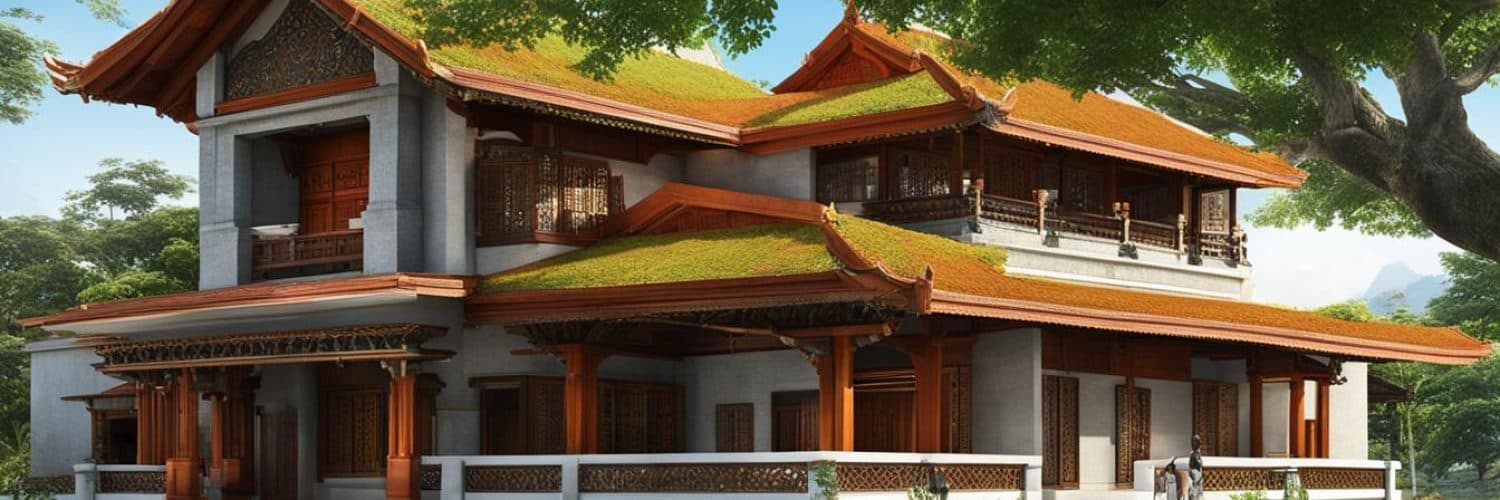Welcome to the Samar Folklore Museum, a cultural treasure nestled in Samar, Philippines. Immerse yourself in the vibrant tapestry of local culture and heritage as you explore this captivating museum. Showcasing the rich traditions and folklore of Samar, the museum offers a unique and insightful journey through time.
Discover the diverse exhibits that bring to life the history, mythology, and spiritual practices of the region. From ancient artifacts and indigenous crafts to sacred shrines and natural wonders, the museum provides a comprehensive exploration of Samar’s cultural heritage. Step into the enchanting world of mythical beings, witness the beauty of traditional crafts, and gain a deeper understanding of the local traditions that have shaped Samar’s identity.
Whether you are a history enthusiast, art lover, or simply curious about the rich cultural tapestry of Samar, the Samar Folklore Museum is a must-visit destination. Join us as we celebrate and preserve the unique traditions that make Samar truly special.
Key Takeaways:
- Explore the rich culture and heritage of Samar at the Samar Folklore Museum.
- Immerse yourself in the mythology and folklore of the region.
- Discover sacred shrines and spiritual grounds that pay homage to ancestral spirits and deities.
- Uncover the natural beauty of Samar through its breathtaking caves and landscapes.
- Experience the cultural practices and traditions rooted in Samar’s folklore and mythology.
Exploring the History and Mythology of Samar
Samar, a province in the Philippines, is known for its captivating history and rich mythology. The region is steeped in fascinating tales of mythical beings, legendary animals, and heroic figures. These stories have been passed down through generations, shaping the cultural fabric of Samar and captivating imaginations.
Philippine mythology encompasses a diverse range of beings that dwell in the realms between the mortal and the divine. In Samar, one encounters the likes of the Aswang, a shape-shifting creature that feasts on human flesh, and the Berbalang, a vampiric beast that brings illness and misfortune. There are also beings like the ethereal Diwata, often depicted as beautiful forest spirits, and the mischievous Duwende, small guardians of the home.
One cannot explore Samar’s mythology without mentioning the heroes that populate its folklore. These include the lazy yet clever Juan Tamad, who constantly outwits those around him, and the fearsome Tikbalang, a half-human, half-horse creature that guards the mountains and forests. Other heroes like Ama-ron and Bernardo Carpio are revered for their supernatural strength and unwavering bravery.
Mythical animals also find their place in Samar’s folklore. The majestic Bakunawa, a giant sea serpent, is believed to cause eclipses by devouring the moon, while the Ekek is a bird-like creature with a peculiar fondness for human hearts. The towering Kapre inhabits large trees and is known to puff cigar smoke, and the Limokon is a mischievous creature that resides in bamboo thickets.
The rich mythology of Samar is deeply rooted in indigenous Tagalog beliefs and folk religions that flourished long before the arrival of colonizers. These belief systems embraced animism and revered ancestral spirits, deities, and nature. They reflected the connection between the people and their surroundings, emphasizing respect for the land, the sea, and the celestial forces.
Tagalog Beliefs and Pre-Colonial Religion
“The indigenous peoples of Samar practiced a variety of folk religions, each with its own rituals, ceremonies, and beliefs. These practices were integral to their daily lives, providing a sense of identity, spiritual connection, and harmony with the world around them.”
The diversity and depth of Samar’s mythology and folklore are a testament to the rich cultural heritage that has shaped the region. These stories continue to be treasured and passed on to future generations, ensuring the preservation of the vibrant traditions that make Samar truly unique.
Notable Mythical Beings in Samar
| Mythical Beings | Description |
|---|---|
| Aswang | A shape-shifting creature that feasts on human flesh. |
| Berbalang | A vampiric beast that brings illness and misfortune. |
| Diwata | Ethereal forest spirits often depicted as beautiful creatures. |
| Duwende | Small guardians of the home, known for their mischievous nature. |
| Juan Tamad | A lazy yet clever character who outwits those around him. |
| Mariang Makiling | A mountain goddess associated with healing and protection of nature. |
| Bakunawa | A giant sea serpent believed to cause eclipses. |
| Kapre | A towering creature that resides in large trees. |
The unique blend of mythical beings, legendary animals, and indigenous beliefs in Samar’s history and mythology adds depth and intrigue to the cultural heritage of the region. Exploring these tales offers a fascinating glimpse into the rich tapestry of Samar’s folklore.
Sacred Shrines and Spiritual Grounds in Samar
Samar is a land of deep spirituality and reverence, where sacred shrines and spiritual grounds hold great significance in the lives of its people. These hallowed places, known as Anito, serve as portals to connect with ancestral spirits and divine beings. The local community cherishes these ancient traditions and continues to honor their ancestors through rituals and offerings at these sacred sites.
Designed in various sizes and structures, Anito shrines encompass a range of architectural styles. From humble roofed platforms nestled amidst lush greenery to grand pagoda-like structures that dominate the skyline, each shrine has a unique presence that reflects the local culture and beliefs.
Mesmerizing Anito Shrine Structures
The diversity of Anito shrines in Samar is truly awe-inspiring. Let’s explore a few remarkable examples:
| Shrine | Structure | Description |
|---|---|---|
| Sanctuary of Ancestral Spirits | A majestic shrine with towering spires, adorned with intricately carved symbols of ancestral spirits. Its breathtaking beauty and intricate details draw pilgrims from far and wide, seeking blessings and guidance from their forefathers. | |
| Grove of Serenity | A serene shrine nestled within a lush forest. Its harmonious blend of natural elements and carefully placed stone structures invites contemplation and spiritual renewal. | |
| Divine Gateway | A magnificent entrance adorned with intricate carvings that symbolize the divine connection between the mortal world and the realm of spirits. Passing through this gateway is believed to grant access to ancient wisdom and blessings. |
Visiting these sacred shrines and spiritual grounds is not just a religious experience, but an opportunity to immerse oneself in the living history and cultural heritage of Samar. The palpable sense of peace and reverence found within these sacred spaces is truly transformative.
Step into the world of Anito shrines and embark on a spiritual journey where the past and present merge in a tapestry of devout beliefs and sacred practices.
These shrines and spiritual grounds in Samar are not only sacred to the local community but also serve as a gateway for outsiders to gain a deeper understanding of Philippine folklore and indigenous traditions. They offer a glimpse into the rich tapestry of beliefs that have shaped the identity of Samar and its people.
Embark on a pilgrimage to these mystical Anito shrines and experience the profound spiritual energy that envelops Samar, connecting past and present, mortal and divine.
Exploring the Natural Beauty of Samar
Samar, known for its stunning landscape and rich biodiversity, offers a multitude of natural wonders that are sure to captivate adventurers and nature enthusiasts alike. One of the highlights of Samar’s natural beauty is its extensive network of caves, each with its own unique charm and allure.
One of the must-visit caves in Samar is the Sohoton Cave. Located in Rawis, Basey, this cave is famous for its majestic rock formations and underground rivers. Explore the labyrinthine passages and be amazed by the breathtaking stalactites and stalagmites that adorn the cave’s interior. As you navigate through the cave, you may even encounter the resident colony of bats that call Sohoton Cave their home.
Another notable cave in Samar is Lobo Cave, situated in Jiabong. Lobo Cave is renowned for its natural pools and tranquil atmosphere, offering visitors a refreshing retreat from the outside world. Take a dip in the cool waters or simply marvel at the cave’s impressive formations, creating a picturesque setting that is perfect for relaxation and contemplation.
Linao Cave in Sta. Margarita is also worth a visit. This cave is known for its enchanting rock formations, including the towering columns and delicate curtains of stone that decorate its chambers. Explore the hidden corners of Linao Cave and discover the wonders that lie beneath the surface.
For those seeking a more challenging adventure, the Calbiga Caves in Calbiga offer a thrilling experience. These caves comprise a complex system of interconnected chambers and underground rivers, providing endless opportunities for exploration. Traverse through the winding paths and witness the natural splendor of this subterranean marvel.
Langun-Gobingub Cave, Guinogo-an Cave, Central Cave, Danao Cave, and Luksoon Cave are among the other notable cave systems in Samar. Each cave offers its own unique features and attractions, ranging from spectacular rock formations to hidden underground rivers. Exploring these caves allows visitors to forge a deeper connection with the natural beauty of Samar and witness the incredible wonders that lie beneath the surface.
Folklore and Mythology in Cultural Practices
The cultural practices of Samar are deeply intertwined with the rich folklore and mythology of the region. These traditional tales and stories have been passed down through generations, keeping the oral tradition alive and thriving. They serve as a window into the history, beliefs, and traditions of the Samar people, reflecting their deep connection to the land and its mythical beings.
One fascinating aspect of this cultural heritage is the incorporation of mythical symbols and motifs in indigenous crafts. Local artisans showcase their skills by creating intricate artworks that pay homage to the folklore and mythology of Samar. These crafts, ranging from woven textiles to hand-carved sculptures, beautifully capture the essence of Philippine folklore and its enchanting tales.
| Indigenous Crafts | Traditional Folklore | Cultural Preservation | Philippine Folklore |
|---|---|---|---|
| Woven textiles | Aswang | Education and awareness | Mariang Makiling |
| Woodcarvings | Berbalang | Documentation and research | Tikbalang |
| Pottery | Diwata | Community engagement | Bakunawa |
Cultural preservation efforts are of utmost importance to ensure that these traditional folklore and crafts continue to thrive. Organizations and communities are actively involved in preserving and promoting the cultural heritage of Samar. This includes educational initiatives, documentation and research projects, and community engagement programs that aim to pass on the knowledge and skills related to traditional practices.
Preserving our cultural heritage is not just about preserving the past; it is about creating a bridge between generations, fostering a sense of identity, and inspiring future generations to carry on our cherished traditions.
By safeguarding the indigenous crafts and traditional folklore of Samar, we contribute to the preservation and celebration of Philippine folklore as a whole. These cultural practices are not only beautiful expressions of art and storytelling but also a testament to the resilience and rich history of the Samar people.
Through preserving and promoting these cultural practices, we ensure that the vibrant traditions and fascinating mythology of Samar remain a cherished part of our collective heritage for generations to come.
Samar Folklore Museum: A Journey Through Time
The Samar Folklore Museum offers a captivating journey through the history and traditions of Samar, immersing visitors in the rich cultural heritage of the region. Through its extensive collection of museum exhibits, the museum showcases a diverse range of artifacts that depict the local traditions and way of life in Samar.
| Exhibit | Description |
|---|---|
| Traditional Costumes | The exhibit features a stunning display of traditional costumes worn by the people of Samar, showcasing the intricate craftsmanship and vibrant colors that reflect the local culture. |
| Musical Instruments | Explore a collection of traditional musical instruments used in Samar, providing a glimpse into the melodic expressions of the local traditions and celebrations. |
| Household Items | From utensils to woven mats, this exhibit showcases the everyday items used by the locals, revealing the practicality and ingenuity embedded in traditional Samar households. |
| Tools | Discover an array of traditional tools used in agriculture, fishing, and craftsmanship, highlighting the resourcefulness and adaptability of the local communities. |
Each exhibit in the Samar Folklore Museum tells a story, providing visitors with a deeper understanding and appreciation for the cultural heritage of Samar. Walking through the museum is like taking a step back in time, as you are immersed in the customs, rituals, and local traditions that have shaped the identity of the region.
By preserving and showcasing these artifacts, the museum plays a crucial role in cultural preservation, ensuring that the local traditions are passed down to future generations. It fosters a sense of pride among the community and promotes awareness and respect for the cultural diversity of Samar.
Visiting the Samar Folklore Museum is not just a journey through time, but also an opportunity to engage with the vibrant cultural tapestry of Samar. It is a chance to appreciate the artistry, craftsmanship, and the stories behind each artifact, deepening our connection to the local traditions and the importance of cultural preservation.
Celebrating Philippine Folklore and Traditions
The Samar Folklore Museum is a vibrant celebration of Philippine folklore and traditions. Through its vast collection, the museum aims to raise awareness and promote the rich cultural heritage of Samar. Visitors to the museum have the unique opportunity to immerse themselves in the indigenous crafts, traditional practices, and captivating folklore that have shaped the identity of the region.
The museum takes pride in preserving and showcasing these invaluable aspects of Samar’s cultural tapestry. By doing so, it contributes to the cultural enrichment of both locals and tourists, allowing them to appreciate the beauty and depth of Philippine folklore. The exhibits and educational programs offered by the museum provide a captivating insight into the centuries-old traditions and beliefs that continue to influence the lives of the people in Samar.
“The Samar Folklore Museum stands as a testament to the richness and diversity of our cultural heritage. Through its exhibits and immersive experiences, visitors can truly engage with the traditions, stories, and crafts that are at the heart of our identity.”
– Mayor Anna Cruz, Samar City
One of the highlights of the museum is the vast collection of indigenous crafts. The masterpieces created by local artisans are a testament to their skills and creativity, incorporating mythical symbols and motifs into their works. By showcasing these crafts, the museum not only preserves the rich artistic traditions but also provides a platform for these talented artisans to gain wider recognition and appreciation for their craftsmanship.
The importance of preserving and celebrating Philippine folklore and traditions cannot be overstated. These cultural practices form the backbone of the community, fostering a sense of identity, unity, and pride among the people of Samar. The Samar Folklore Museum serves as a beacon, shining a light on the cultural significance of these traditions and inspiring future generations to embrace and carry them forward.
The Diversity of Indigenous Crafts
Samar’s indigenous crafts are as diverse as its folklore. The skilled artisans create intricate weavings, exquisite pottery, and intricately carved wooden pieces. These crafts not only showcase the artistic talents of the locals but also serve as a bridge between the past and the present, connecting generations through the continuation of time-honored techniques.
Here are some examples of indigenous crafts from Samar:
| Craft | Description |
|---|---|
| T’nalak Weaving | A traditional weaving technique used by the T’boli tribe, producing vibrant and intricate patterns on abaca fiber. |
| Pottery | The art of creating pottery using various techniques, including coiling, slab building, and wheel throwing. |
| Bamboo Craft | The skilled use of bamboo to create functional items such as baskets, furniture, and musical instruments. |
| Woodcarving | The intricate art of carving wood to create sculptures, masks, and religious icons. |
These stunning indigenous crafts not only serve as decorative pieces but also tell stories and legends through their intricate designs. They are a living testament to the rich cultural heritage of Samar and deserve to be celebrated and preserved for future generations to appreciate.
Samar Folklore Museum: Promoting Cultural Exchange
The Samar Folklore Museum serves as a vibrant platform for cultural exchange and appreciation. It invites visitors from around the world to delve into the rich cultural heritage of Samar, Philippines. By showcasing the local traditions, indigenous crafts, and cultural practices, the museum fosters a deeper understanding and respect for the diverse communities that call Samar home.
At the Samar Folklore Museum, dialogue and interaction are encouraged, allowing visitors to engage with the local traditions and gain firsthand knowledge of the artistic skills involved in creating indigenous crafts. This direct engagement promotes cultural diversity and fosters a sense of unity among different communities, creating a unique opportunity for cultural exchange.
The museum’s exhibits highlight the importance of preserving and celebrating cultural heritage, providing visitors with a glimpse into the rich tapestry of local traditions that have been passed down through generations. From traditional costumes and musical instruments to household items and tools, each artifact tells a story of the people and their way of life.
Through its immersive and educational experiences, the Samar Folklore Museum enables visitors to appreciate the depth and beauty of the region’s cultural heritage. It serves as a bridge between past and present, connecting visitors to the roots of Samar’s identity through its vibrant folklore and time-honored traditions.
| Benefits of the Samar Folklore Museum: |
|---|
| 1. Promotes cultural exchange and appreciation |
| 2. Fosters unity among different communities |
| 3. Preserves and celebrates cultural heritage |
| 4. Provides a deeper understanding of indigenous crafts and local traditions |
| 5. Showcases the diversity of Samar’s cultural tapestry |
Visiting the Samar Folklore Museum is an enriching experience that allows individuals to engage with and appreciate the cultural heritage of Samar. It is a testament to the value of preserving local traditions and the importance of cultural exchange in fostering unity and understanding among different communities.
Conclusion
The Samar Folklore Museum is a testament to the rich culture and heritage of Samar, Philippines. Through its exhibits, the museum preserves the traditional folklore and crafts of the region, ensuring that future generations can learn, appreciate, and celebrate their cultural heritage. It offers a captivating journey through time, allowing visitors to delve into the vibrant cultural tapestry of Samar.
By showcasing the mythical beings, historical artifacts, and local traditions that have shaped Samar’s identity, the museum acts as a bridge for cultural exchange. It welcomes visitors from all over the world, promoting dialogue and interaction that foster a deeper understanding and appreciation for the local traditions and artistic skills involved in creating indigenous crafts.
Visiting the Samar Folklore Museum is a truly enriching experience. It provides an opportunity to explore the diverse cultural heritage of Samar, and to recognize the importance of cultural preservation. The museum not only serves as a guardian of the past but also as an ambassador for the cultural richness of the region, inviting everyone to experience and celebrate the vibrant traditions that make Samar truly unique.
FAQ
What is the Samar Folklore Museum?
The Samar Folklore Museum is a cultural treasure located in Samar, Philippines. It showcases the rich heritage and traditions of the region through historical artifacts and indigenous crafts.
What does the Samar Folklore Museum exhibit?
The museum exhibits a wide range of artifacts, including traditional costumes, musical instruments, household items, and tools. Each exhibit tells a story of the local traditions and way of life, providing visitors with a deeper understanding and appreciation for the cultural heritage of Samar.
What is the significance of the folklore and mythology of Samar?
The folklore and mythology of Samar are deeply rooted in the culture of the region. They showcase the rich oral tradition and cultural practices that have been passed down through generations. These traditions are reflected in the indigenous crafts created by local artisans, who incorporate mythical symbols and motifs into their works.
How does the Samar Folklore Museum contribute to cultural preservation?
The museum plays a vital role in preserving and promoting the local folklore and traditions of Samar. Through its exhibits and educational programs, it raises awareness and ensures that these cultural practices continue to thrive.
Can visitors learn about the indigenous crafts and traditional practices at the Samar Folklore Museum?
Yes, the Samar Folklore Museum provides visitors with an opportunity to learn about the indigenous crafts, traditional practices, and unique folklore that have shaped the identity of the region.
Does the Samar Folklore Museum promote cultural exchange?
Yes, the museum serves as a platform for cultural exchange and appreciation. It welcomes visitors from all over the world, allowing them to learn about the cultural heritage of Samar and fostering a sense of unity among different communities.
What is the purpose of the shrines and sacred grounds in Samar?
The shrines, known as Anito, in Samar serve as places for communication with ancestral spirits and deities, as well as for leaving offerings. They hold great cultural significance and are an integral part of the indigenous Philippine folklore and traditions.
Are there natural wonders to explore in Samar?
Yes, Samar offers a plethora of natural wonders, including numerous caves. Some of the remarkable cave systems in Samar include Sohoton Cave, Lobo Cave, Linao Cave, Calbiga Caves, Langun-Gobingub Cave, Guinogo-an Cave, Central Cave, Danao Cave, and Luksoon Cave.
What is the role of traditional folklore and stories in the cultural practices of Samar?
Traditional folklore and stories are deeply rooted in the cultural practices of Samar. They are passed down through generations, keeping the rich oral tradition alive. This is reflected in the indigenous crafts created by local artisans.


















Add comment